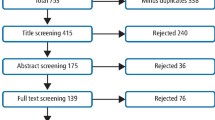Abstract
Data sources
Data were sourced from the Cochrane Oral Health Groups Specialised Register, Cochrane Central Register of Controlled Trails, Medline, bibliographic references of identified systematic reviews, prospective cohort studies and clinical trials, textbooks and review articles.
Study selection
The studies included presented validating criteria for caries incidence/ increment and were limited to those with human subjects and natural carious lesions. Only studies published in peer reviewed journals were included. Excluded were studies which gave an incomplete description of sample selection, or of outcome, or had a small sample size. Studies which did not meet the Oxford Centre for Evidence Based Medicine prognosis category criteria for best evidence were also excluded.
Data extraction and synthesis
Data were extracted by the first review author and were independently checked by a second author. The criteria reported in the ADA Clinical Recommendations Handbook1 were used to assess the quality of the studies. Adjustments made for potential confounders were considered as a means to evaluate the internal validity of each study.
Results
One hundred and thirty-seven study reports remained for review following systematic strategic search and title review. Of these, six studies of existing caries risk assessment models were selected for inclusion. Of the six studies reviewed four were deemed ‘fair’ by the ADA criteria and two ‘poor’. The authors found variation in the parameters used for caries risk assessment and the population groups studied. No study found the risk assessment systems to have reliable prediction utility in children. One prospective study found Cariogram to give good to moderate caries prediction in elderly adults and one retrospective study found the CAMBRA assessment to provide prediction for cavitated lesions, but only between low risk and extreme risk individuals over the age of six.
Conclusions
This systematic review suggests that evidence available on the validity of a number of existing systems for caries risk assessment is limited and weak.
Similar content being viewed by others
Log in or create a free account to read this content
Gain free access to this article, as well as selected content from this journal and more on nature.com
or
References
Center for Evidence Based Dentistry American Dental Association. ADA Clinical Recommendations Handbook. October 29, 2009.
Harris R, Nicoll AD, Adair PM, Pine CM . Risk factors for dental caries in young children: a systematic review of the literature. Community Dental Health 2004. 21 (Suppliment), 71–85.
MacRitchie HM, Longbottom C, Robertson M, Nugent Z, Chan K, Radford JR, Pitts NB . Development of the Dundee Caries Risk Assessment Model (DCRAM) – risk model development using a novel application of CHAID analysis. Community Dentistry and Oral Epidemiology 2012. Feb; 40: 37–45.
Author information
Authors and Affiliations
Additional information
Address for correspondence: Marisol Tellez, Maurice H Kornberg School of Dentistry, Temple University, Philadelphia, PA, USA. E-mail: marisol@dental.temple.edu
Tellez M, Gomez J, Pretty I, Ellwood R, Ismail A. Evidence on existing caries risk assessment systems: are they predictive of future caries? Community Dent Oral Epidemiol 2012; Sep 15. doi: 10.1111/cdoe.12003. [Epub ahead of print] PubMed PMID: 22978796.
Rights and permissions
About this article
Cite this article
Carson, S. Limited evidence for existing caries assessment systems. Evid Based Dent 14, 10–11 (2013). https://doi.org/10.1038/sj.ebd.6400911
Published:
Issue date:
DOI: https://doi.org/10.1038/sj.ebd.6400911



